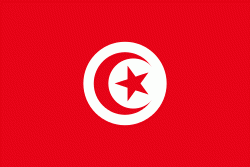Medenine
Medenine (مدنين ) is the major town in south-eastern Tunisia, 77 km south of the port of Gabès and the Island of Djerba, on the main route to Libya. It is the capital of Medenine Governorate.
In pre-colonial times, Medenine was already the most important trading centre in the south, attracting merchants from all over North Africa and even from Bornu, to the south of the Sahara. The Ksar housed the central granaries of the various nomadic Berber tribes of the region.
The area was the scene of an unsuccessful German counter-attack by General Erwin Rommel as part of Operation Capri during March 1943 against British Eighth Army forces. The Battle of Medenine was Rommel's last engagement in Africa before he was replaced by General Hans-Jürgen von Arnim as commander of the Afrika Korps.
In pre-colonial times, Medenine was already the most important trading centre in the south, attracting merchants from all over North Africa and even from Bornu, to the south of the Sahara. The Ksar housed the central granaries of the various nomadic Berber tribes of the region.
The area was the scene of an unsuccessful German counter-attack by General Erwin Rommel as part of Operation Capri during March 1943 against British Eighth Army forces. The Battle of Medenine was Rommel's last engagement in Africa before he was replaced by General Hans-Jürgen von Arnim as commander of the Afrika Korps.
Map - Medenine
Map
Country - Tunisia
 |
 |
| Flag of Tunisia | |
Beginning in early antiquity, Tunisia was inhabited by the indigenous Berbers. Phoenicians began to arrive in the 12th century BC, establishing several settlements, of which Carthage emerged as the most powerful by the 7th century BC. Carthage was a major mercantile empire and a military rival to the Roman Republic until 146 BC, when it was defeated by the Romans who occupied Tunisia for most of the next 800 years. The Romans introduced Christianity and left architectural legacies like the Amphitheatre of El Jem. In the 7th century AD, Arab Muslims conquered all of Tunisia (finally succeeding in 697 after several attempts starting in 647) and settled with their tribes and families, brought Islam and Arab culture to the local inhabitants, and since then Arabs became the majority of the population. Then, in 1546, the Ottoman Empire established control there, holding sway for over 300 years, until 1881, when the French conquered Tunisia. In 1956, Tunisia gained independence as the Tunisian Republic under the leadership of Habib Bourguiba with the help of activists such as Chedly Kallala, Farhat Hached and Salah Ben Youssef. Today, Tunisia's culture and identity are rooted in this centuries-long intersection of different cultures and ethnicities.
Currency / Language
| ISO | Currency | Symbol | Significant figures |
|---|---|---|---|
| TND | Tunisian dinar | دت | 3 |
| ISO | Language |
|---|---|
| AR | Arabic language |
| FR | French language |















